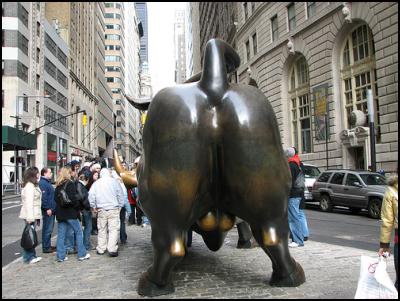AIG Spoke but Gave No Answers
AIG Spoke but Gave No Answers

Image cc
"What the Hell Is The Real Story?"
by Chris White
So, now we know, two thirds of the bail out money which went to AIG between October and the end of December wasn’t intended for AIG at all, but was passed through to others. The list includes Goldman Sachs, Morgan Stanley, Deutsche Bank, Societé Generale, and many others. And, if that wasn’t enough to make you choke on your coffee this morning, there’s the additional fuel of the AIG bonus story. OMG, this is just like totally over the top.
There’s a lot of outrage about this which is kind of being stoked by the media, and there’s some useful commentaries which are dealing with parts of the story. These three from Robert Kuttner Robert Reich and the America’s Future blog are ones to take cognizance of, I think. In Kuttner's view Obama's financial team is leading him to destruction. Reich raises his voice against the corruption, and so do the folks over at Progressive Breakfast in their morning release.
The outrage is directed at the upfront particulars, the bonuses and the pass-through laundering of bail-out funds. I think though there is a picture beginning to emerge of the structure of the Paulson-Bernanke bailout which raises a whole range of other issues. The banks continue to insist that their assets will come good with a rebound in the economy, and therefore their current pricing structure should be preserved. Yves Smith provided a major service this morning over at Naked Capitalism when she made available Bruce Krasting's discussion of the AIG bonuses and Tyler Durden's guest post on bailout spotting.
Now what is coming into focus is what looks like the effort to preserve the structure underlying the pricing of what the banks call their assets. Beyond today’s outrage there are questions which we all need to have answered. There are for sure people who can put this together a whole lot better than I can. So far the ones who know how the whole thing is working are on the side of gouging the tax payer for as much as they can get.
Let's take the case of mortgage-backed securities. Fannie Mae, packages mortgages into the form of securities which can be sold. Here is Fannie Mae's account. To be securitized in this way, the loan must also feature a down payment, or private insurance to remove the risk of default on the first 20% of the loan from Fannie Mae. AIG among others used to do this, and according to Krasting, astoundingly still does. What exactly is a Fannie Mae originated mortgage-backed security? It is a claim to the income, in the form of interest and principal payments generated from a poll of mortgages. The security takes the form of what is called a "pass through certificate," the certificate transfers the rights to receive a proportional share of the income from pool.
The income from many such pools was, and maybe still is in lesser amounts, bought by banks and others as a flow of cash. This flow of cash from mortgages, along with other such flows, is then used to provide the income which investors have bought from the bank and other sellers of derivative products and synthetic security constructions. AIG's Credit Default Swaps insured the created structures which were passing through income drawn from sources like Fannie Mae against default. AIG, and possibly other writers of Mortgage Insurance, are at both ends of the process, covering for missing down payments, and issuing CDS's to protect those who are buying income passed through derivative "structures." The insurers, like AIG, make the flow possible.
There are three areas, I think: first, he initial securitization of the income produced from mortgages and the role insurers in that; second, the use to which the cash from mortgage securitization is put by the purchasers of pass through certificates and other such instruments; and, third, the part played by insurers in the Credit Default Swap business, and other parts of the derivatives racket.
The flows made it possible for banks to appear solvent as well as liquid. Just as long as new monies kept on coming. The issue now is if, and to what extent TARP funds, and the facilities created out of the FDIC, and Federal Reserve, partially have been able to replicate that financial cycle using tax payer funds as a replacement for the interest and repayments thrown off by mortgages, and whether these tax payer funds are underwriting derivative structures which are being insured as the CDO's and Synthetic CDO's used to be insured. This could be determined by finding out where the money comes from, where and who it is going to, and what it does on the way.
Questions
First, are insurance companies like AIG, still underwriting private mortgage insurance for Fannie Mae and related issuers of mortgage securities, and if so, on what terms? PMI (Private Mortgage Insurance is what covers the gap between borrowers’ loan/loans and the appraised price of the property. Krasting says they are, and that AIG continues to be one of the insurers offering such guarantees. Are those insurers also writing CDS's against the debt securities of banks which used those flows?
Second, are Fannie Mae and other Government Sponsored Enterprises involved in the mortgage business still securitizing non-conforming loans if there is a 20% cushion underwritten by private insurers like AIG?
Third, what proportion of GSE sourced cash flow is thrown off as the income from such privately insured non-conforming mortgages?
Fourth, to what extent has the FDIC’s Temporary Loan Guarantee Program (TLGP) offset the collapse of mortgage security generated cash flows out of which banks and their holding companies paid interest and other charges on their senior secured debt? This program was set up last October to guarantee new senior secured debt issuance of qualified institutions including bank holding companies and banks and other qualified institutions. This kind of debt is bought by insurance companies and pension funds among others. Durden is taking up this question.
Five, what proportion of the corporate debt held by insurance companies and pension funds is bank or bank holding company senior secured debt?
Six, what is the volume of credit default swaps written on the bank and bank holding company debt, and how much of that has been guaranteed by the FDIC’s TLGP.
Seven, what is the source of the funds banks and bank holding companies are presently using to continue to service their debt obligations, including those held by insurance companies and pension funds? Are TARP funds, whether provided directly, or indirectly (AIG laundry) in the absence of cash flow from mortgage pass through certificates, and cash flows associated with other securitization, the only such source of funds to service bank debt held by insurance companies and pension funds?
Eight, how much of the cash flow either originating in mortgage pass through certificates, or secured by the FDIC’s TGLP, programs like TAF and CPFF, has been diverted into banks’ premium, commission and fee charges whether for processing, underwriting or the purchase and sale of credit default swaps, or other derivative instruments?
Nine, does the siphoning of funds into derivative products on which banks, bank holding companies, insurance companies, and others, charge each other fees, commissions, premiums and other service charges off set the effect of the public guarantees which the Federal Reserve and Treasury are directing into their bail out programs like the FDIC’s TGLP and others, and if so to what extent.
Now that the insurance companies are beginning to line up to ask for their share of TARP funds, and that Corporations are anticipated to continue to fail in record numbers, how is it that both the Federal Reserve and the Treasury continue to hold out hopes that programs which are undermined by rising employment and residential foreclosures can off set the countervailing derivative hedges which seem to be the program’s most successful by-product?
In a Ponzi scheme the new money coming into the system is used to pay off some of the investors, partially or completely, but is treated as the personal property of the scheme’s organizer. The issue on which such schemes rise or fall is always the relationship between new money coming in and recurring claims for payment given an existing rate of growth of investors in the system.
The issue here is the extent to which the new money coming in, if there are other sources than TARP and Federal Reserve facilities and credit lines and swaps, is sufficient to continue to meet the demands for pay-offs from existing investors in the overall pool, as well as the organizers.
Now consider mortgage securitization, and securitization of other debt classes, including the US Treasury’s debt bundled interest and principle payments for sale as a continuing stream of income. This income stream was used to “pay off” investors through underwriting the sale of income producing “structures”, like CDO’s and synthetic CDO’s, which were off-shore vehicles designed to pass through income presented as the imitation of the behavior of underlying asset classes which were protected by the sale of default swaps, it was claimed. The sellers of the income streams, and the off-shore structures, also made their money from fees, commissions and service charges.
All these sources, which dominated the final phase, have pretty much dried up. Therefore, one is entitled to ask, I think, what all the TARP and related funds, facilities, and swaplines are really being used for, and just why anyone should be asinine enough to think this would be sustainable long enough to outrun the collapse in employment and business activity which is feeding the wave of foreclosures and defaults so widely expected for the rest of the year?
Since unemployment and foreclosures worsen the financial problem, but the financial solutions pursued to date also worsen the unemployment foreclosure problems, why should we continue to listen to people who claim the financial problems have to be solved before anything else?
Roll Up, Roll Up, Want to buy protection against the collapse of the Federal Reserve? You're sure you are not looking for a nice bridge? We've got plenty of those. I can let you have a potion which will protect you against just about anything. How much?
You've got it all backwards, how much are you prepared to pay? That's all you've got right now? Never mind it'll have to do for now I guess. Here you go. Don't drink it all at once. Oh, you'd better give it a day or so to work. See you around sometime!


 Gordon Campbell: On The Coalition’s Awful, Not Good, Very Bad Poll Results
Gordon Campbell: On The Coalition’s Awful, Not Good, Very Bad Poll Results Ian Powell: Policy Vacuum Enables For-profit Corporate General Practice Ownership By Stealth
Ian Powell: Policy Vacuum Enables For-profit Corporate General Practice Ownership By Stealth Gordon Campbell: On Iran Killing Its Rappers, And Searching For The Invisible Dr. Reti
Gordon Campbell: On Iran Killing Its Rappers, And Searching For The Invisible Dr. Reti Peter Dunne: MPs Unusually Quiet On Pay Rise
Peter Dunne: MPs Unusually Quiet On Pay Rise Ian Powell: Cuba And New Zealand: A Relationship Worthy Of Strengthening
Ian Powell: Cuba And New Zealand: A Relationship Worthy Of Strengthening Gordon Campbell: On bird flu, AUKUS entry fees and Cindy Lee
Gordon Campbell: On bird flu, AUKUS entry fees and Cindy Lee